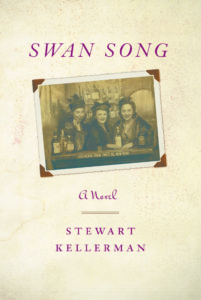 Reviewed by Ruth Latta
Reviewed by Ruth Latta
Swan Song
by Stewart Kellerman
Rushwater
Paperback, 280 pp, $9.99, ISBN 978-0-9801532-8-6
Stewart Kellerman’s Swan Song is an entertaining story about a couple who retire to Florida in the 1980s. Through the witty first person narration of the protagonist, Selma Waxler, the author shows the concerns of older adults, which are pretty much the same in the 21st century as they were in the 1980s.
When Selma’s husband Sid retires from his teaching position in Yonkers, New York, in 1981, they move to a retirement development, Pelican Pond, on the “space coast” of Florida. In their mid-sixties, these “young” seniors, still in relatively good health, are able to enjoy many activities. Selma participates in fitness and music programs and charitable organizations, but Sid’s favourite activity is “pull-ups”. “He’d pull on the lever of his La-Z-Boy to make the back go down and the footrest go up,” says Selma.
When Sid wants to attend a talk on money management, she is elated that he’s tearing himself away from the TV. “Little did I realize,” she says, “once the genie was out I wouldn’t be able to get him back in the bottle.”
Selma’s best friends’ husbands are also at loose ends without their jobs. Kitty’s husband, Leo, has his mind on the hardware business he left behind in New York in the hands of their daughter. Rose’s husband, Sol, eats. Kitty, Rose and Selma still have their work as homemakers and are better than their spouses at socializing.
The heartwarming story of the three women friends is a unifying thread in the novel. They met as children living on Livonia Avenue in Brooklyn, and became inseparable. Kitty, “the brave one”, introduced the other two to Chinese food, and pursued her love of dance into a career at Radio City Music Hall. Rose and Selma, had more prosaic jobs, Rose in the garment industry and Selma in a shoe store. Several times she tells the reader that she did not merely sell shoes, but did accounts, and that her high school teachers all wanted her to go on to college. Higher education, however, was beyond her parents’ means.
Through flashbacks, readers learn about Selma’s parents’ generation One of the most inspiring characters is Zissel, Selma’s mother, who immigrated to America in 1907 and worked in sweatshop conditions until the International Ladies Garment Workers Union improved things. Though she married a carpenter from her home village in Russia who earned a living in America, she always worked outside the home, progressing in her craft to embroidering designer dresses and making wedding gowns. She mothered Selma’s friend Kitty and offered her money for her dance lessons.
“The hardest work in life is to be idle, Selma,” she said in her old age. Selma carries on her mother’s tradition of kindness to others, hard work and caution with money. Listening to real estate developer, Arlee Sparling, talk about “wealth management”, her suspicions are aroused. He’s too friendly – “a false front like the town in a cowboy movie.” Dismissive of conservative investments, he warns his audience that if they do nothing with their money they’ll outlive their savings.
Sid’s involvement with Arlee Sparling’s mortgage and real estate schemes is the spine of the novel, providing the dramatic tension, but Selma is the heart of the story. Her humour, reminiscences and her common sense opinions bring the story to life. When she raises objections to Sid investing their money, he dismisses her, saying “Women just don’t understand these things.” When she asks, “Why can’t we stop when we’re ahead?” he replies: “If it were up to you the human race would still be crawling on all fours.”
After Sid’s financial adventures bring the novel to a climax, the rest of the story shows the sadder aspects of old age. Even so, we see the characters savouring everyday pleasures and blessings, and staying connected to friends who come through for each other in crises.
While the back cover blurb of Swan Song has a condescending tone, the front cover is delightful. A photograph shows three smiling young women in 1930s finery, out on the town, smile at the camera. In her Foreword, Kellerman’s wife, author Patricia T. O’Connor, says that it’s a family photo of Kellerman’s mother Edith, flanked by her two best friends. Both of Kellerman’s parents, now deceased, gave him information about growing up in New York City in the early 20th century. Swan Song’s appeal lies in the characters, who, in O’Connor’s words, “are universal and at the same time so utterly individual.”
For more information on Ruth Latta’s upcoming novel, Votes, Love and War, about the Manitoba women’s suffrage movement and World War I, visit her blog, http://ruthlatta.blogspot.com